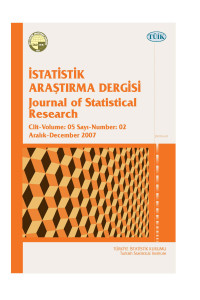Research Article
Year 2007,
Volume: 5 Issue: 2, 52 - 68, 14.12.2007
Abstract
Partial least squares (PLS) is used for obtaining the smallest number of orthogonal latent variables (component) that explain the great amount of variation in the original independent variables which have multicollinearity. Since it is applicaple to various disciplines different algorithms have been developed for PLS. In this study, NIPALS which is the first and basic algorithm of PLS and SIMPLS developed by De Jong in 1993 will be described and illustrated on an health data set.
References
- De Jong, S., 1993. SIMPLS: An alternative approach to partial least squares regression. Chemometrics and Intelligent Laboratory Systems 18,251-263.
- Geladi, P., Kowalski, R., 1986. Partial least squares regression: A tutorial. Analytica Chimica Acta 185, 1-17.
- Helland, I. S., 1988. On the structure of partial least squares regression. Communications in Statistics l7(2), 581-607.
- Höskuldsson, A., 1988. PLS regression methods. Journal of Chemometrics 2, 211- 228.
- Lindgren, F., Rännar, S., 1998. Alternative partial least-squares (PLS) algorithms. Perspectives in Drug Discovery and Design 12/13/ 14, 105-113.
- Randall, D. Tobias., 1996. An introduction to partial least squares regression. SAS Institute Inc., Cary, NC. http://support.sas.com/techsup/teclmote/ts509.pdf, 11 Şubat 2008.
- Rawlings, J. O., 1988. Applied regression analysis: A research tool. Cole Advanced Books&Software. California.
- Wold, S., Sjostrom, M., Eriksson, L., 2001. PLS-regression: A basic tool of chemometrics. Chemometrics and Intelligent Laboratory Systems 58, 109-130.
Year 2007,
Volume: 5 Issue: 2, 52 - 68, 14.12.2007
Abstract
Kısmi en küçük kareler (KEKK) yöntemi, aralarında çoklu doğrusal bağlantı bulunan açıklayıcı değişkenler içerisinden, bu değişkenlerdeki değişimin büyük kısmını açıklayacak, dik ve daha az sayıda gizli değişkeni (bileşen) bulmakla ilgilenir. Farklı alanlarda farklı amaçlar doğrultusunda kullanımından dolayı, KEKK için farklı algoritmalar ortaya çıkarılmıştır. Bu çalışmada KEKK için en temel algoritma olan NIPALS, 1993 yılında De Jong tarafından geliştirilen ve yaygın olarak kullanılan SIMPLS algoritmalarına değinilmiş, bir örnek üzerinde uygulama gösterilmiştir.
References
- De Jong, S., 1993. SIMPLS: An alternative approach to partial least squares regression. Chemometrics and Intelligent Laboratory Systems 18,251-263.
- Geladi, P., Kowalski, R., 1986. Partial least squares regression: A tutorial. Analytica Chimica Acta 185, 1-17.
- Helland, I. S., 1988. On the structure of partial least squares regression. Communications in Statistics l7(2), 581-607.
- Höskuldsson, A., 1988. PLS regression methods. Journal of Chemometrics 2, 211- 228.
- Lindgren, F., Rännar, S., 1998. Alternative partial least-squares (PLS) algorithms. Perspectives in Drug Discovery and Design 12/13/ 14, 105-113.
- Randall, D. Tobias., 1996. An introduction to partial least squares regression. SAS Institute Inc., Cary, NC. http://support.sas.com/techsup/teclmote/ts509.pdf, 11 Şubat 2008.
- Rawlings, J. O., 1988. Applied regression analysis: A research tool. Cole Advanced Books&Software. California.
- Wold, S., Sjostrom, M., Eriksson, L., 2001. PLS-regression: A basic tool of chemometrics. Chemometrics and Intelligent Laboratory Systems 58, 109-130.
There are 8 citations in total.
Details
| Primary Language | Turkish |
|---|---|
| Subjects | Statistics |
| Journal Section | Research Articles |
| Authors | |
| Publication Date | December 14, 2007 |
| Published in Issue | Year 2007 Volume: 5 Issue: 2 |

